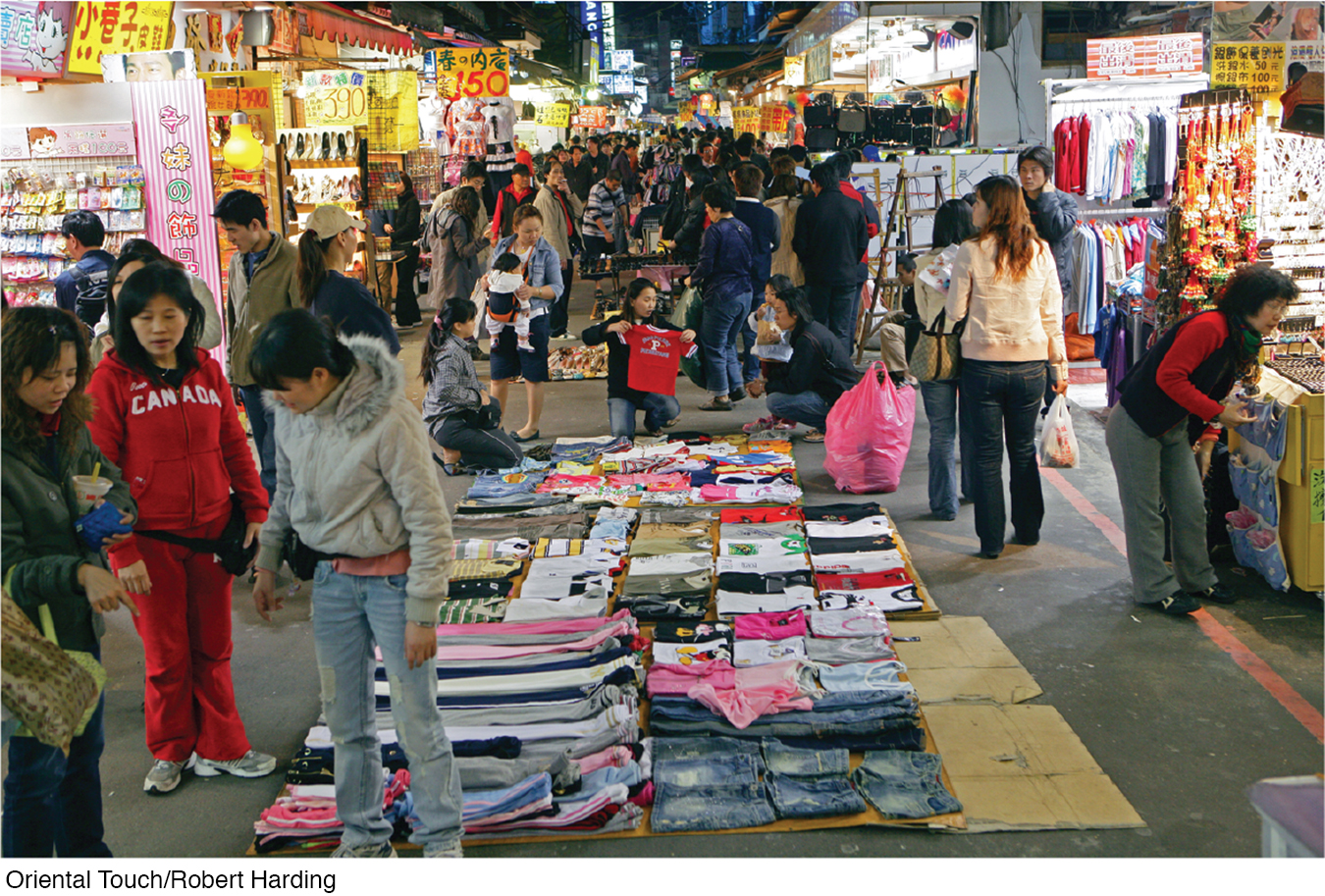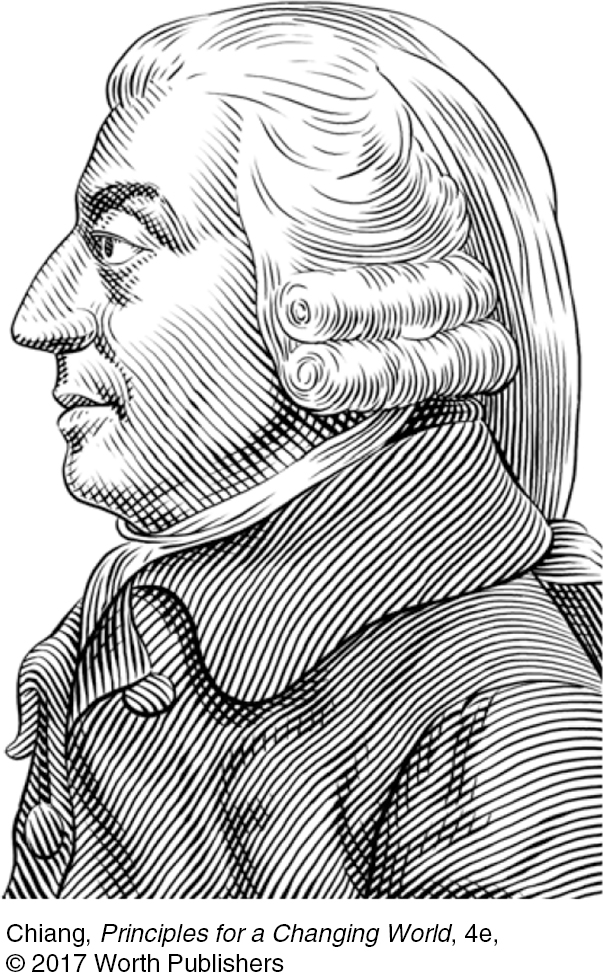KEY PRINCIPLES OF ECONOMICS
Economics has a set of key principles that show up continually in economic analysis. Some are more restricted to specific issues, but most apply universally. These principles should give you a sense of what you will learn in this course. In the following, we summarize eight key principles that will be applied throughout the entire book. By the end of this course, these principles should be crystal clear and you will likely find yourself using these principles throughout your life, even if you never take another economics course.
Principle 1: Economics Is Concerned With Making Choices With Limited Resources
Economics deals with nearly every type of decision we face each day. But when a typical person is asked what economics is about, the most common answer is “money.” Why is economics commonly misconceived as dealing only with money? This may be due in part to how economics is portrayed in the news—
Economics is about making decisions on allocating limited resources to maximize an individual or society’s well-
In sum, many aspects of life contribute to the well-
Principle 2: When Making Decisions, One Must Take Into Account Tradeoffs and Opportunity Costs

Wouldn’t it be great if we all had the resources of Mark Zuckerberg (the founder of Facebook) and could buy just about any material possession one could possibly want? Most likely we won’t, so back to reality.
We all have limited resources. Some of us are more limited than others, but each of us, even Mark Zuckerberg, faces limitations (and not because Mark chooses to wear a $30 shirt instead of a $3,000 Brioni suit). For example, we all face time limitations: There are only 24 hours in a day, and some of that must be spent sleeping. The fact that we have many wants but limited resources (scarcity) means that we must make tradeoffs in nearly everything we do. In other words, we have to decide between alternatives, which always exist whenever we make a decision.
opportunity cost The value of the next best alternative; what you give up to do something or purchase something.
How is this accomplished? What factors determine whether you buy a nicer car or use the extra money to pay down debt? Or whether you should spend the weekend at a local music festival or use the time to study for an exam? Economists use an important term to help weigh the benefits and costs of every decision we make, and that term is opportunity cost. In fact, economics is often categorized as the discipline that always weighs benefits against costs.
At its very core, opportunity cost is determined by asking yourself, in any situation, “What could I be doing right now if I weren’t _____________ (fill in the activity)?” or “What could I have bought if I hadn’t bought this _______________ (fill in the last good or service you bought)?” In other words, opportunity cost measures the value of the next best alternative use of your time or money, or what you give up when you make an economic decision. And since there are always alternatives, one cannot avoid opportunity costs.
A common mistake that people make is that they sometimes do not fully take their opportunity costs into account. Have you ever camped out overnight in order to get tickets for a concert? Was it even worth going to the concert? Opportunity cost includes the value of everything you give up in order to attend the concert, including the cost of the tickets and transportation, and the time spent buying tickets, traveling to and from the venue, and of course attending the concert. The sum of all opportunity costs can sometimes outweigh the benefits.
Another example of miscalculating opportunity costs occurs when a student spends a copious amount of time to dispute a $15 parking ticket. Like the previous example, the opportunity cost (time and effort disputing the ticket that can be used for some other activity) may exceed the $15 savings if successful and certainly if the attempt to dispute the ticket fails.
In other cases, individuals do respond to opportunity costs. Why do many people choose a paper towel over a hand dryer in a public restroom when given the choice? It’s because the opportunity cost of using the hand dryer is higher than using a paper towel.
Every activity involves opportunity costs. Sleeping, eating, studying, partying, running, hiking, and so on, all require that we spend resources that could be used on another activity. Opportunity cost varies from person to person. A company president rushing from meeting to meeting has a higher opportunity cost than a retired senior citizen, and therefore is more likely to choose the quickest option to accomplish day-
Opportunity costs apply to us as individuals and to societies as a whole. For example, if a country chooses to spend more on environmental conservation, it must use resources that could be used to promote other objectives, such as education and health care.
Principle 3: Specialization Leads to Gains for All Involved
Whenever we pursue an activity or a task, we use time that could be used for other activities or tasks. However, sometimes these other tasks are best left to others to perform. Life would be much more difficult if we all had to grow our own food. This highlights the idea that tradeoffs (especially with one’s time) can lead to better outcomes if one is able to specialize in activities in which she or he is more proficient.
Suppose you and your roommate can each cook your own dinner and clean your own rooms. Alternatively, you might have your roommate clean both rooms (he’s better at it than you) in exchange for you preparing dinner for two (you’re a better cook). Using this arrangement, both tasks are completed in less time since each of you is specializing in the activity you’re better at, plus both of you will benefit from a cleaner apartment and a tastier dinner.
Therefore, specialization in tasks in which one is more proficient can lead to gains for all parties as long as exchange is possible and those involved trade in a mutually beneficial manner. Each person is acting on the opportunity to improve his or her well-
Principle 4: People Respond to Incentives, Both Good and Bad
Each time an individual or a firm makes a decision, that person or firm is acting on an incentive that drives the individual or firm to choose an action. These incentives often occur naturally. For example, we choose to eat every day because we face an incentive to survive, and we study and work hard because we face an incentive to be successful in our careers. However, incentives also can be formed by policies set by government to encourage individuals and firms to act in certain ways, and by businesses to encourage consumers to change their consumption habits.
For example, tax policy rests on the idea that people respond to incentives. Do we want to encourage people to save for their retirement? Then let them deduct a certain amount that they can put into a tax-
ISSUE
Would a City Change Its Name for a Game Show?

Driving along Interstate 25 in central New Mexico, one encounters a city with a very peculiar name, one that required the state’s Department of Transportation to order extra-
In 1950 a popular radio game show called Truth or Consequences, hosted by Ralph Edwards, offered a challenge. If any city was willing to rename itself Truth or Consequences, Mr. Edwards would host his show from that location. Hot Springs saw this as an opportunity to raise its city profile, and therefore acted on the incentive to be the first and only city to accept the challenge. It subsequently changed its official name to Truth or Consequences, New Mexico, a name that remains in use.
Truth or Consequences has benefited from its name change long after it. The city continues to host an annual fiesta that welcomed Mr. Edwards in person every year for the 50 years that followed the name change. Today, Truth or Consequences remains a small city of 6,500 residents and is still popular for its natural springs. But on the horizon is another famous person, Richard Branson, the founder of Virgin Galactic, who plans to develop a commercial space flight industry in New Mexico. The location, Spaceport America, is just 30 miles from Truth or Consequences, another attraction that will add to the city’s unique character.
Tax policy is an obvious example in which people follow incentives. But this principle can be seen in action wherever you look. Want to encourage people to fly during the slow travel season? Offer price discounts or bonus frequent flyer miles for flying during that time. Want to increase business at restaurants? Give early-
Note that in saying that people follow incentives, economists do not claim that everyone follows each incentive every time. Though you may not want to eat dinner at 5:00 P.M., there might be other people who are willing to eat earlier in return for a price discount.
If not properly constructed, incentives might lead to harmful outcomes. During the 2008 financial crisis, it became clear that the way incentives for traders and executives were set up by Wall Street investment banks was misguided. Traders and executives were paid bonuses based on short-
Responding to badly designed incentives is often described as greed, but they are not always the same. If you found a $20 bill on the sidewalk, would you pick it up? Of course, but would that make you a greedy person? The stranger who accidentally dropped the bill an hour ago might think so, but you are just responding to an incentive to pick up the money before the next lucky person does. Could incentives ever be designed to prevent people from picking up money they find? It may surprise you that one industry has: In many casinos, it is prohibited to keep chips or money you find on the floor.
The natural tendency for society to respond to incentives leads individuals and firms to work hard and generate ideas that increase productivity, a measure of a society’s capacity to produce that determines our standard of living. A worker who can do twice as much as another is likely to earn a higher salary, because productivity and pay tend to go together. The same is true for nations. Countries with the highest standards of living are also the most productive.
Principle 5: Rational Behavior Requires Thinking on the Margin
Have you ever noticed that when you eat at an all-
In this case, people are just rationally responding to the price of additional food. They are thinking on the margin. In a nonbuffet restaurant, dessert costs extra, and you make a decision as to whether the enjoyment you receive from the dessert (the marginal benefit) is worth the extra cost (the marginal cost). At the buffet, dessert is included, which means the marginal cost is zero. Even so, you still must ask yourself if dessert will give you satisfaction. If the dessert tastes terrible or adds unwanted calories to your diet, then you might pass on dessert even if it is free. But the fact that one is more likely to have dessert at a buffet than at a menu-
The idea of thinking on the margin applies to a society as well. Like asking ourselves whether we want another serving of dessert, a society must ask itself whether it wants a little bit more or a little bit less of something, and policymakers and/or citizens vote on such policy proposals. An example of society thinking on the margin is whether taxes should be raised a little to pay for other projects, or whether a country should send up another space exploration craft to study other planets.
Throughout this book, we will see examples of thinking on the margin. A business uses marginal analysis to determine how much of its products it is willing to supply to the market. Individuals use marginal analysis to determine how many hours to exercise or study. And governments use marginal analysis to determine how much pollution should be permitted.
Principle 6: Markets Are Generally Efficient; When They Aren’t, Government Can Sometimes Correct the Failure
Individuals and firms make decisions that maximize their well-
Competition for the consumer dollar forces firms to provide products at the lowest possible price, or some other firm will undercut their high price. New products enter the market and old products die out. Such is the dynamic characteristic of markets.
What drives and disciplines markets? Prices and profits are the keys. Profits drive entrepreneurs to provide new products (think of Apple) or existing products at lower prices (think of Walmart). When prices and profits get too high in any market, new firms jump in with lower prices to grab away customers. This competition, or sometimes even the threat of competition, keeps markets from exploiting consumers.
Individuals and firms respond to prices in markets by altering the choices and quantities of goods they purchase and sell, respectively. These actions highlight the ability of markets to provide an efficient outcome for all. Markets can achieve this efficiency without a central planner telling what people should buy or what firms should sell. This phenomenon that markets promote efficiency through the incentives faced by individuals and firms (as if they were guided by an omnipotent force) is referred to as the invisible hand, a term coined by Adam Smith, considered the father of modern economics.
As efficient as markets usually are, society does not desire a market for everything. For example, markets for hard drugs or child pornography are largely deemed undesirable. In other cases, a market does not provide enough of a good or service, such as public parks or public education. For these products and services, markets can fail to provide an optimal outcome.
But when markets do fail, they tend to do so in predictable ways. Where consumers have no choice but to buy from one firm (such as a local water company), the market will fail to provide the best solution, and government regulation is often used to protect consumers. Another example is pollution: Left unregulated, companies often will pollute the air and water. Governments then intervene to deal with this market failure. Finally, people rely on information to make rational decisions. When information is not readily available or is known only to one side of the market, markets again can fail to produce the socially desirable outcome.

We also can extend the idea of market efficiency to the greater economy. The market forces of supply and demand generally keep the economy in equilibrium. But occasionally, fluctuations in the macroeconomy will occur, and markets take time to readjust on their own. In some cases, the economy becomes stuck in a severe downturn. In these instances, government can smooth the fluctuations in the overall economy by using policies such as government spending or tax cuts. But remember, just because the government can successfully intervene does not mean it always successfully intervenes. The macroeconomy is not a simple machine. Successful policymaking is a tough task.
Principle 7: Economic Growth, Low Unemployment, and Low Inflation Are Economic Goals That Do Not Always Coincide
The reliance on private markets and reasonable government intervention aims to maximize societal gains in terms of higher incomes and standards of living. The key to higher standards of living is economic growth, which can be measured a number of ways, most commonly by estimating the change in a country’s real gross domestic income per capita. Yet, other measures of economic growth include average household income, quality of education, infrastructure development, improvement in technology and innovation, environmental sustainability, and poverty reduction.
The goal of economic growth is fostered by policies set by government, including fiscal policy and monetary policy. But things are not always so simple, given the two persistent economic obstacles that naturally occur in the economy: unemployment and inflation. Unemployment and inflation often run opposite to one another; for example, when unemployment is high, inflation is generally low, and vice versa. When either unemployment or inflation is too high, economic growth can be inhibited. Government policy is therefore used to correct one problem at the potential expense of exacerbating the other.
ADAM SMITH (1723–1790)
When Adam Smith was 4 years old, he was kidnapped and held for ransom. Had his captors not taken fright and returned the boy unharmed, the history of economics might well have turned out differently.

Born in Kirkaldy, Scotland, in 1723, Smith graduated from the University of Glasgow at age 17 and was awarded a scholarship to Oxford. Smith considered his time at Oxford to be largely wasted. Returning to Scotland in 1751, Smith was named Professor of Moral Philosophy at the University of Glasgow.
After 12 years at Glasgow, Smith began tutoring the son of a wealthy Scottish nobleman. This job provided him with the opportunity to spend several years touring the European continent with his young charge. In Paris, Smith met some of the leading French economists of the day, which helped stoke his own interest in political economy. While there, he wrote a friend, “I have begun to write a book in order to pass the time.”
Returning to Kirkaldy in 1766, Smith spent the next decade finishing An Inquiry Into the Nature and Causes of the Wealth of Nations. Before publication in 1776, he read sections of the text to Benjamin Franklin. Smith’s genius was in taking the existing forms of economic analysis available at the time and putting them together in a systematic fashion to make sense of the national economy as a whole. Smith demonstrated how individuals left free to pursue their own economic interests end up acting in ways that enhance the welfare of all. This is Smith’s famous “invisible hand.” In Smith’s words: “By directing that industry in such a manner as its produce may be of the greatest value, he intends only his own gain, and he is in this, as in many other cases, led by an invisible hand to promote an end which was no part of his intention.”
How important was Adam Smith? He has been called the “father of political economy.” Many of the foundations of economic analysis we still use today are based on Adam Smith’s writings of several centuries ago.
Sources: Howard Marshall, The Great Economists: A History of Economic Thought (New York: Pitman Publishing), 1967; Paul Strathern, A Brief History of Economic Genius (New York: Texere), 2002; Ian Ross, The Life of Adam Smith (Oxford: Clarendon Press), 1995.
In 2015 the U.S. Federal Reserve faced an important decision: whether to raise interest rates, which had been kept very low for almost a decade, to address unemployment stemming from the financial crisis of 2007?2009. Although raising interest rates would help keep inflation from rising, doing so may cause unemployment to rise. Determining policy to boost economic growth is like walking a tightrope: One must stay balanced to prevent toppling over to one side.
Principle 8: Institutions and Human Creativity Help Explain the Wealth of Nations
We have seen how individuals and firms make decisions to maximize their well-
Institutions include a legal system to enforce contracts and laws and to protect the rights of citizens and the ideas they create, a legislative process to develop laws and policies that provide incentives to individuals and firms to work hard, a government free of corruption, and a strong monetary system.

Nunavut: Land of Abundance and Scarcity
How does the condition of scarcity determine the economic tradeoffs observed in Canada’s newest and largest province?
What products is Canada known for? Canada is a northern country known for its lakes and forests. And what are forests made of? Trees, of course. How important are trees? Just ask the 32,000 residents in the newest Canadian province of Nunavut. They know, because they have no trees!

Larger in area than Alaska and California combined, Nunavut has many natural resources, but lacks the one resource most often associated with Canada: trees. With much of Nunavut’s land mass situated above the tree line, it must rely on goods supplied by other provinces and imported from other countries for its building materials and agricultural products. A visit to Nunavut highlights the prevalence of scarcity and the necessity of specialization and trade.
For example, nearly all of Nunavut’s food, household goods, and building materials must be flown in to its sparsely populated communities accessible only by air or snowmobile, resulting in extremely high prices for most goods. However, Nunavut has many gold mines and fisheries that allow it to specialize and export precious metals and its famous Arctic char fish, a close relative to the salmon.
Residents of even the most remote places of the world can solve the challenge of scarcity and gain access to many goods and services by engaging in specialization and trade.
GO TO  TO PRACTICE THE ECONOMIC CONCEPTS IN THIS STORY
TO PRACTICE THE ECONOMIC CONCEPTS IN THIS STORY
Equally as important as institutions is the ability of societies to create ideas. Ideas change civilizations. Ideas are the basis for creating new products and finding new ways to improve existing goods and services. Human creativity starts with a strong educational system, and builds with proper incentives that allow innovation and creativity to flourish into marketable outcomes to improve the lives of all.
Summing It All Up: Economics Is All Around Us
The examples presented in these key principles should have convinced you that economic decisions are a part of our everyday lives. Anytime we make a decision involving a purchase, or decide what we plan to eat, study, or do with our day, we are making economic decisions. Just keep in mind that economics is broader than an exclusive concern with money, despite the great emphasis placed on money in our everyday economic discussions.
Instead, economics is about making decisions when we can’t have everything we want, and how we interact with others to maximize our well-
The key principles discussed in this chapter will be repeated throughout this book, and you will learn more about these important principles as the term progresses. For now, realize that economics rests on the foundation of a limited number of important principles. Once you fully grasp these basic ideas, the study of economics will be both rewarding and exciting, because after this course you will discover and appreciate how much more you understand the world around you.
CHECKPOINT
KEY PRINCIPLES OF ECONOMICS
Economics is concerned with making choices with limited resources.
When making decisions, one must take into account tradeoffs and opportunity costs.
Specialization leads to gains for all involved.
People respond to incentives, both good and bad.
Rational behavior requires thinking on the margin.
Markets are generally efficient; when they aren’t, government can sometimes correct the failure.
Economic growth, low unemployment, and low inflation are economic goals that do not always coincide.
Institutions and human creativity help explain the wealth of nations.
QUESTION: McDonald’s introduced a premium blend of coffee that sells for more than its standard coffee. How does this represent thinking at the margin?
Answers to the Checkpoint questions can be found at the end of this chapter.
McDonald’s is adding one more product (premium coffee) to its line. Thinking at the margin entails thinking about how you can improve an operation (or increase profits) by adding to your existing product line or reducing costs.